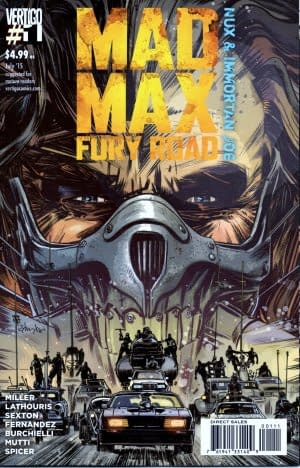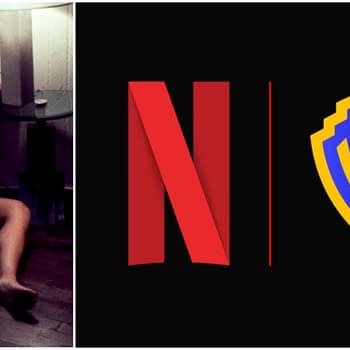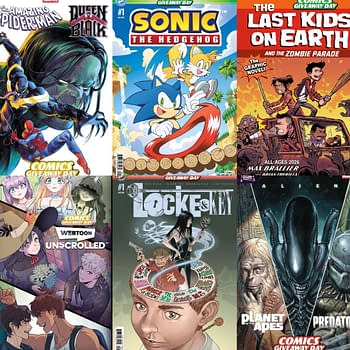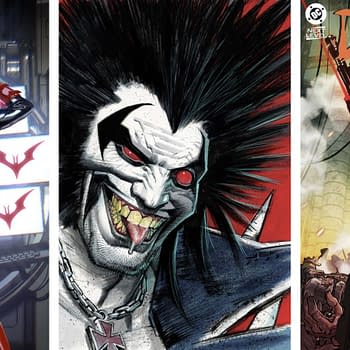Posted in: Comics, Recent Updates | Tagged: Academia Waltz & Other Profound Transgressions TPB, berkeley breathed, Comics, entertainment, mad max: fury road, vertigo
Thor's Comic Review Column – Mad Max: Fury Road, Academia Waltz & Other Profound Transgressions TPB
This Week's Reviews:
Mad Max: Fury Road: Nux & Immortan Joe #1
Mad Max: Fury Road: Furiosa #1
Mad Max: Fury Road: Max #1 – 2
Academia Waltz & Other Profound Transgressions TPB
Mad Max: Fury Road: Nux & Immortan Joe #1
Mad Max: Fury Road: Furiosa #1
Mad Max: Fury Road: Max #1 – 2
(Vertigo, $4.99 ea)
By Graig Kent
Almost inconceivably, the fourth installment of the cinematic Mad Max franchise — a franchise, mind, that had laid relatively dormant for close to two decades — has become the high water mark for action and genre movies this summer, if not for all such features for years to come. It's script is one of deceptive simplicity, featuring a story that barely allows for more than a one-act structure. It's a script with minimal amount of dialogue (particularly from its protagonist) that is so carefully crafted as to build characters, relationships, societies, religions, and the world of the film with beautiful subtlety, but can equally be ignored and the entertainment value of the film still remains.
But it is that subtlety, the glimpses of a brilliantly realized world, that has drawn many a viewer back in the theatre, myself included. The spectacle of Fury Road, that relentless there-and-back 100-minute chase sequence, is a marvel indeed, and it holds up to repeated viewings impeccably well. But in those same repeated viewings the layers of depth, especially of the Citadel society under Immortan Joe's rule, begin to reveal themselves. The characters of the film feel uncovered, rather than introduced, and the sense that there's so much more to them than what is on screen is evident. It's not burning, mind you, the desire to have any questions about these characters answered, but it's certainly not something I would pass the opportunity up to see or read about.
Enter the Vertigo mini-series/anthology that acts as a quasi-sequel and quasi-prequel to the film while also elaborating upon the film's characters and society, and even bridging the lengthy gap between Mel Gibson's run on the character and this new iteration. These four books spring from the mind of George Miller, with Fury Road storyboard artist Mark Sexton and screenplay co-writer Nico Lathouris scripting them, so these aren't just semi-detached licensed product off-shoots from the movie ala many a Terminator or Predator or Alien or countless other cinematic properties which get a comic book tie-in. It's not that such tie-ins can't be entertaining, but it's extremely rare for them to feel authentic to the cinematic experience. These Max books fit into that rare occasion where they may not be integral to the Fury Road filmgoing experience, but they enhance it greatly, and they don't interfere or overstep, leaving the film intact, if not enriched as a result.

The story of Immortan Joe (with art from Riccardo Burchielli) isn't strictly Joe's origin either, it actually helps to fill in some of the gaps between Mad Max and Mad Max 2 (The Road Warrior). The knowledge keeper explains, through Joe's story, how the world fell, and fell fast. It starts with how these military men, men who once did violence on behalf of the people, are now the same men who terrorize and take for themselves. Colonel Joe Moore was a hard and tactical man and a leader to the worst of these men, which made him feared. The keeper tells of Joe's taking of the Citadel, a near impossible task which, in succeeding, elevated him from legend to God. He built a society, a cult, that was his, and his alone. But egotistical men worry less about building a better world than maintaining control, even in death, and he sought to have the perfect heir.
It would be this devotion to extending his rule, if by proxy, that would be his downfall. It's in broad strokes that we see Joe's society develop, but we see the results of most of the particulars in the film, so the broad swath is enough. Through narration and montage, we get the sense that Joe's rise was swift, but not instantaneous, that it grew. At first many saw the change as positive, but his ousting of one tyrannical society from the citadel was obviously replaced by another. The cyclical nature of humanity, of not learning lessons from the past, is a thread the lore keeper uses to string all these stories together.
The art for both stories from Fernandez and Burchielli hew heavy on the shadows but pull detailed influence from Fury Road wonderfully. Burchielli digs even deeper, back to early post-Apocalypse, drawing more influence from the original Mad Max in his designs, though stepping them forward in time ever so slightly, so as not to be as extreme as Mad Max 2 but showing the markings of a much crueler, more violent world.

Miller, Lathouris and Sexton took a page from their own work and put Furiosa in the background of her own story. This book is as much, if not more about the wives/breeders of Immortan Joe, and the lives they lead before we were introduced to them in Furiosa's War Rig in the film. In its own way, focusing on them in that time is even trickier a tightrope walk, as the film made such strides to ignore their supermodel-esque qualities and to show their strength not as victims but fighters and survivors. To take them back to their time as captives, to show their abuse at the hands of Joe and his cadre of disgusting creeps, could go any number of ways, fall into any manner of cliches, doing more harm than good.
But I have to say, after reading through this issue three times over, I'm more than impressed with Lathouris and Sexton's script. Again, so much of the measure of the story is building upon what's seen in the film and deepening the world, but at the same time, this story really shows the solidarity of the wives, their resolve to not be victims, and their ability to transcend what is happening to them, to not let it define them, to hope and even reach for something more. As their tutor, Miss Giddy, teaches them, "there's no shame in what he forces you to do."
The narrator, the lore keeper, relates that it was Immortan Joe's downfall to educate the women. It's a parable for how many societies in the world operate, keeping the population ignorant in order to maintain control of them. But in Immortan Joe's world, women are nothing, barely worth considering, vehicles for his legacy and nothing more. To give them knowledge he didn't even consider it a possibility they would use it against him. In this story it's intoned that Joe is not just a tyrant and a rapist, but a pedophyle, in lust over his War Boys, such that he powders up his wives to look the part (if he couldn't get any creepier..).
Furiosa comes into the story as a lackey of Joe's, put on guard to watch the breeders as much as protect them. But once more, it's Joe's disregard for women that was his failing. He didn't consider that Furiosa might ultimately relate to these women, these trapped people who are strong, but can't fight, not the way she can. He didn't even suspect she would be his downfall. She's a warrior in the guise of a War Boy. It does take Furiosa some time to shed the veil of Joe's preachings and lies, to ignore what little Joe gives, and instead see what it is he takes.
There is a scene which will cause many to throw the book and its depiction of Furiosa into question, however, as it seems to betray the feminist leanings of the character and Fury Road as a whole. Furiosa catches Angharad,one of the brides, trying to self-abort her fetus using a couple of wires. Furiosa intervenes and lashes out. When she lambastes these girls for their meager privileges and ingratitude, they lash back: "All you know is war…and killing." "And what were you just doing?" she replies. This throws the spectre of the pro-choice/pro-life debate over not just Furiosa but, George Miller, the writing team, and the film itself, taking the conversation into a whole other terrain that maybe it shouldn't go. Can it be that Furiosa, this newest of feminist icons, believes that life begins at conception and that a woman doesn't have a right to choose? Can a character hold that ideology and still be representative of larger feminist ideals? That is a pretty f*cked up thing to do to an audience. But also fascinating.
What's not in play here is Furiosa's background. Though the focusing point of the story, she isn't investigated too deeply (just as Max isn't delved very deeply into in the film). One of the brides questions whether Furiosa was a bride herself? And if so what feelings about children, childbirth and life would she have gained during that time that would lead her to such outrage at Angharad's actions. There was palpably less concern for Angharad's safety than for the child's, at least at that moment. But, I see a couple of points of context worth considering in this regard; firstly, this is a post apocalyptic society where life is utterly devalued, and children are born with no real future. The pro-life/pro-choice debate likely doesn't even exist in this reality anymore.
If there's a healthy child that can potentially be born, I think the majority of characters would have a similar reaction to Furiosa's here. I'm not saying, at all, that the survival of the species negates the validity of a woman's right to choose, but it does add some additional variables into the conversation that don't exist in it today, and those variables may be shaping Furiosa at this moment. Secondly, I think the core of this story is seeing Furiosa's own shift into self-respect, seeing these women as more than just the Breeders that Joe has set them aside for, and seeing herself as more than just the Imperator he has made her. At that moment, when she stops Angharad and berates the women, she's still seeing them as Joe's "breeders", but that perception obviously shifts. Despite throwing a pro-life wrinkle into Furiosa's persona, it retains the strength of women identifying and valuing themselves beyond the definitions society has set out for them.
The art for Furiosa comes from Tristan Jones and Szymon Kuranski. Kuranski is artist for only seven pages, those controversial seven pages featuring the attempted abortion and Furiosa's outrage. The change of artists makes me wonder if those pages weren't reworked to such an extent that they had to scrap the existing pages from Jones entirely and bring in a new artist to redraw them. Kuranski's style melds well with Jones', such that I didn't even notice were it not for the credits, especially considering how colorist Michael Spicer (doing a brilliant job throughout capturing a thousand different colours for dirt and sand) pulls it all together uniformly. That all said, the art is frequently awkward, with figures looking malproportioned, facial expressions looking pulled and unnatural. At times the characters are exceptionally on model, looking like their cinematic counterparts, but just as often they look generic and indistinguishable. It's not unreadable and the illustrators definitely get the point across, but it's not the style I would have preferred for this story.

Using some of the world that Fury Road set up, Max heads into Gastown to enter the new Thunderdome competition (many shall enter, one shall leave) where the winner receives a fully restored V8 engine, something Max covets to get his Interceptor running again. Max is as lucky as he is resourceful and skilled, and the assistance from a woman outside the ring leads Max to victory, but gaining the ire of the Buzzards in doing so. The woman enlists Max's help in rescuing her daughter from the Buzzards, which takes up the second act through to its tragic ending.
While this two-part story of Max doesn't have as much substance as any of the Max films, it feels like a step above a simple throw away story. Lathouris and Sexton (who also handles the art chores throughout) basically reutilize elements from Max's past to drive him deeper into the dirt. The monosyllabic Max of the film is still reeling considerably from the events of this story (events which remind him of his own tragic origin), he's a man withdrawing further and further from society, at every turn trying to pull away. But that cop part of him, the man who wants to serve and protect keeps drawing him to people in need. If we're to believe that Glory here is the girl speaking to Max in flashes in the film (I will need to see the movie once more to confirm), this book serves as a lead-in to Max's story in Fury Road (and it likewise serves to satisfy continuity hounds as to how Max has a souped-up Interceptor once more).
Sexton illustrated all the framing sequences to this point, his exceptionally clean and detailed artwork standing out against the dark sort in Nux & Immortan Joe and Furiosa, so it's nice to see what he can do for an extended story. As a storyboard artist for film, he's obviously got a background well-suited for comic book illustration. He doesn't just rest on what he knows, however and with these two issues delivers a visual story that breaks down the action beat-by-beat but using more dynamic comic page structures. I'm reminded somewhat of Geoff Darrow's Shaolin Cowboy both with artwork intricacy but also with the methodical fighting and action sequences.
Sexton also illustrates at the top a six-page breakdown of the Mad Max trilogy that preceded Fury Road capturing the highlights that shaped the character but also recontextualizing some of it, the least of which being Max looking more Tom Hardy, less Mel Gibson. It's enough to squash those Tom Hardy is the Feral Boy from Road Warrior rumours, at the very least. He's Max.
I love Fury Road, the movie, more and more as I think about it, letting the scenes play in my head, letting the dialogue filter through, letting the world sink in. These comics force me to look at the film a little differently, but in almost every way they enrich the complexity of the world, not just of the film but the series as a whole. One may not like the way the characters and their stories are expanded upon here, particularly the story of the brides and Furiosa will prove challenging to many because they don't hold back the abuse (but they also certainly don't glorify it) but these stories aren't casual, they feel like they matter, and in so many ways, help us understand the film better.
Graig Kent loved Mad Max: Fury Road. It's the first film in a very long time he's watched more than once in the theatre. He didn't really care about the Mad Max series before that. You can read his thoughts on the Mad Max series here.
Academia Waltz & Other Profound Transgressions TPB (IDW, $39.99)
By Cat Taylor

The most fascinating thing about an artist's early work is seeing where he or she started and following the path to where he or she ended up. In Breathed's case, the writing and humor is pretty similar to his work now. Make no mistake, Bloom County is the funnier of the two, but Academia Waltz makes it clear that writing humorous comics is a gift that Breathed possessed early. In both Academia Waltz and Bloom County, Breathed used a consistent cast of characters in a setting with which he was familiar, a small town for Bloom County and the University of Texas for Academia Waltz. He even "graduated" few of his Academia Waltz characters to Bloom County when he started the new strip. Also, rather than the three-panel, set-up, body, punchline joke-style of most comic strips, Breathed was using his established topical-satire humor even in his earliest strips.
What is most interesting about the changes in the style of humor, isn't a change of direction on Breathed's part, but rather a change in his environment. Whereas Bloom County is better known for satirizing social trends and political issues of the world at large, Academia Waltz mostly satirized college life and the University of Texas specifically. Although there are occasional jabs at larger world issues, much of Academia Waltz's humor is so specific that if you didn't live in 1978 and 1979 or never attended college, the jokes will fly right by you. In some cases, the gags are even focused on the University of Texas specifically. So, if you weren't there, you won't get those jokes. Fortunately, there is still plenty material that I found relevant enough to enjoy this collection.
One of the things I most enjoyed about this book was reading topical and political humor from a time before every single issue was solidly considered a Republican or Democrat platform piece and before you HAD to be adamantly on one side or the other. The learning process of discovering where I stood on various issues, without television and partisan internet posts telling me what to think, was one of the more exciting things about college. You can see some of that in these strips where Breathed, while overall pretty liberal, had no problem mocking a few things that by today's standards may have people questioning whether he should have a "D" or "R" by his name. One thing that's glaringly obvious is that there was a lot less concern with "political correctness" in the late 1970s than there is now. Therefore, some people reading a few of these old comics today might incorrectly think that Breathed was being "insensitive" to certain groups.
While Breathed's later work isn't a radical departure from his early days as far as the writing style and humor is concerned, the improvements to his drawings are night and day. The earliest strips in this collection are very crude sketches. Even as he developed his style and became more consistent, the work is still rough and unremarkable. Although, there is obvious progression and improvement by the final strip. Regardless, even the best drawn of the Academia Waltz comics are dog crap compared with his Bloom County drawings. It's truly amazing to see the growth from a guy who could barely sketch a figure to one of the cleanest, most professional, and most distinct styles in the comic strip world. Even people who never read a single panel of Bloom County can easily recognize icons like Opus and Bill the Cat. The same couldn't be said for Academia Waltz's Rabies the dog.
Even though it's a real kick to see these strips all collected in one place, I can't help but point out two minor criticisms. First, is that some of the comics are clearly out of order. Perhaps, as often happens, they were originally published out of order, but with a collection like this it seems like it would have been easy when putting two strips on the same page to put the first one in the story sequence at the top of the page. Is that too much to ask? Second, I understand that completeness is the name of the game here, but there's a lot of unnecessary repetition of material. Out of the over 300 pages, probably about 100 pages are repeated comics from the first part of the book. The reason this occurred is because the first part of the book collects the actual comic strips that ran in the papers, whereas the latter part of the book is work from Breathed's personal archives of original art. Much of that archived art are his personal copies of the strips from the first part of the book. Seeing the original reproductions doesn't add much for me. There's some red ink, some blue ink, and occasionally some barely decipherable scribbled notes in the margins but that's it. Maybe somebody will get something out of seeing them again in the same collection, but I couldn't help but think that by cutting out a lot of repeated material, people could get the same collection for a lower price. I know, I'm nitpicking.
On the whole, this Academia Waltz edition is a treasure trove for Bloom County completists. Whether you want to peer into a late 1970s time capsule, get into the head of Breathed as a young artist, or hanker to see the first appearances of Steve Dallas and Saigon "Cutter" John, this archive makes a great addition to a bookshelf that includes any of Breathed's other trade collections. Just having access to this early work is like being able to finally go out and buy a Holy Grail after years of questing for one.
Cat Taylor has been reading comics since the 1970s. Some of his favorite writers are Alan Moore, Neil Gaiman, Peter Bagge, and Kurt Busiek. Prior to writing about comics, Taylor performed in punk rock bands and on the outlaw professional wrestling circuit. During that time he also wrote for music and pro wrestling fanzines. Right now, it's time for dinner. You can e-mail Cat at cizattaylor@hotmail.com.















